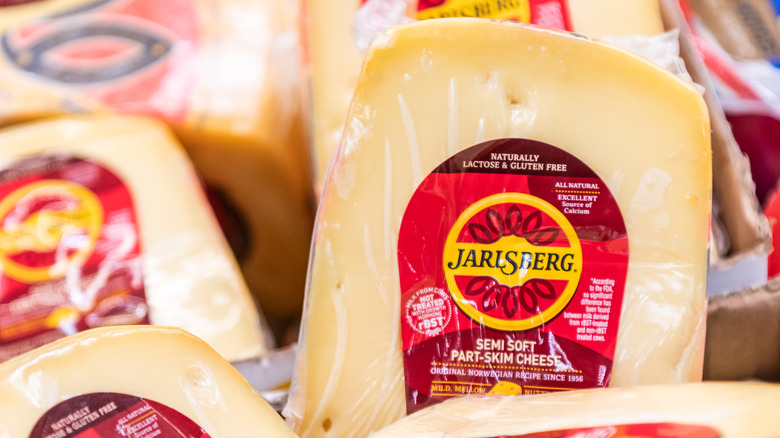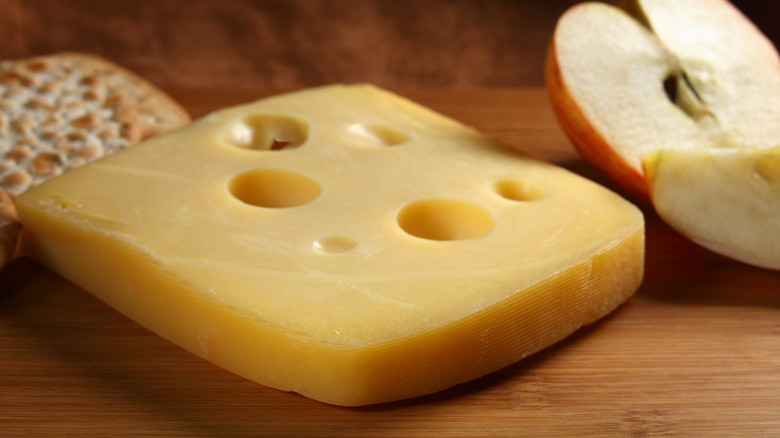The Blend That Makes Jarlsberg Cheese One-Of-A-Kind
Grab your pom-poms. Today, we're cheerleading for less-popular cheeses. Seasoned foodies know well the underrated fantasia that is a runny, pungent, raw milk cheese. "I sing the Camembert stinky," proclaim the contemporary would-be Walt Whitmans and ardent cheese-heads of the world. As of 2020, U.S. foodies put away an average of over 40 pounds of cheese per person per year, an increase of more than five pounds from the previous decade. Judging by statistics, it looks like foodies aren't just eating lots of cheese: they're also experimenting. In 2020, roughly 203 million Americans opted for imported cheeses. Today, we're taking a look at one of the less mainstream yet still accessible imported cheeses on the market: Jarlsberg.
Iconic New York City-based cheesemonger Murray's (which won Best Cheese in America at the 2022 World Cheese Awards) lauds Jarlsberg as the "most popular Norwegian import." At Murray's, a pound of the stuff goes for $25. According to the official Jarlsberg website, the cheese is based on a recipe created in 1956 that today remains heavily guarded. It originated in the namesake Jarlsberg County, a small village in Norway. A more precise recipe was thereafter developed by professor Ole Martin Ystgaard and a team of dairy scientists at the Agricultural University of Norway. Like other cheeses, Jarlsberg's unique recipe is responsible for its taste and texture. But, believe it or not, Jarlsberg is actually made from a blend of two other kinds of cheese, which come together to create a one-of-a-kind fromage.
A Gouda-Swiss fusion
According to Jarlsberg's official website, Jarlsberg is a blend of Gouda and Swiss Emmental cheeses. Jarlsberg is a cow's milk cheese with characteristic large holes (aka "eyes" in cheesemonger lingo, per U.S. Dairy). Jarlsberg's unique eyes are formed by a special patented propionic acid, which also gives the cheese its distinctive flavor. Propionibacteria are natural bacterial cultures that get added to cheese by cheesemongers after pasteurization, which kills much of the naturally-occurring props that would've been in the cheese anyway. In fact, Jarlsberg is technically categorized as part of the Swiss cheese family but bears an unmistakably sweeter and stronger flavor than a classic Swiss Emmental cheese. The authority at Cheese.com describes the taste as mild, buttery, and nutty, with a pale yellow color and semi-soft texture.
If you're hungry to find out for yourself what a Gouda-Swiss combo tastes like, Jarlsberg's official website recommends pairing it with fruits, nuts, and chocolate for a knockout charcuterie board. Plus, as a semi-soft cheese, it slices easily, making for hassle-free entertaining. Since it also melts well, Murray's recommends using it for fondue or in ham and cheese sandwiches. According to a 2022 study by a team of Norwegian researchers, snacking on Jarlsberg can even improve bone health thanks to its naturally high vitamin K2 content. In short, trying a perhaps-unfamiliar cheese is always a good idea — especially when it's this one.

